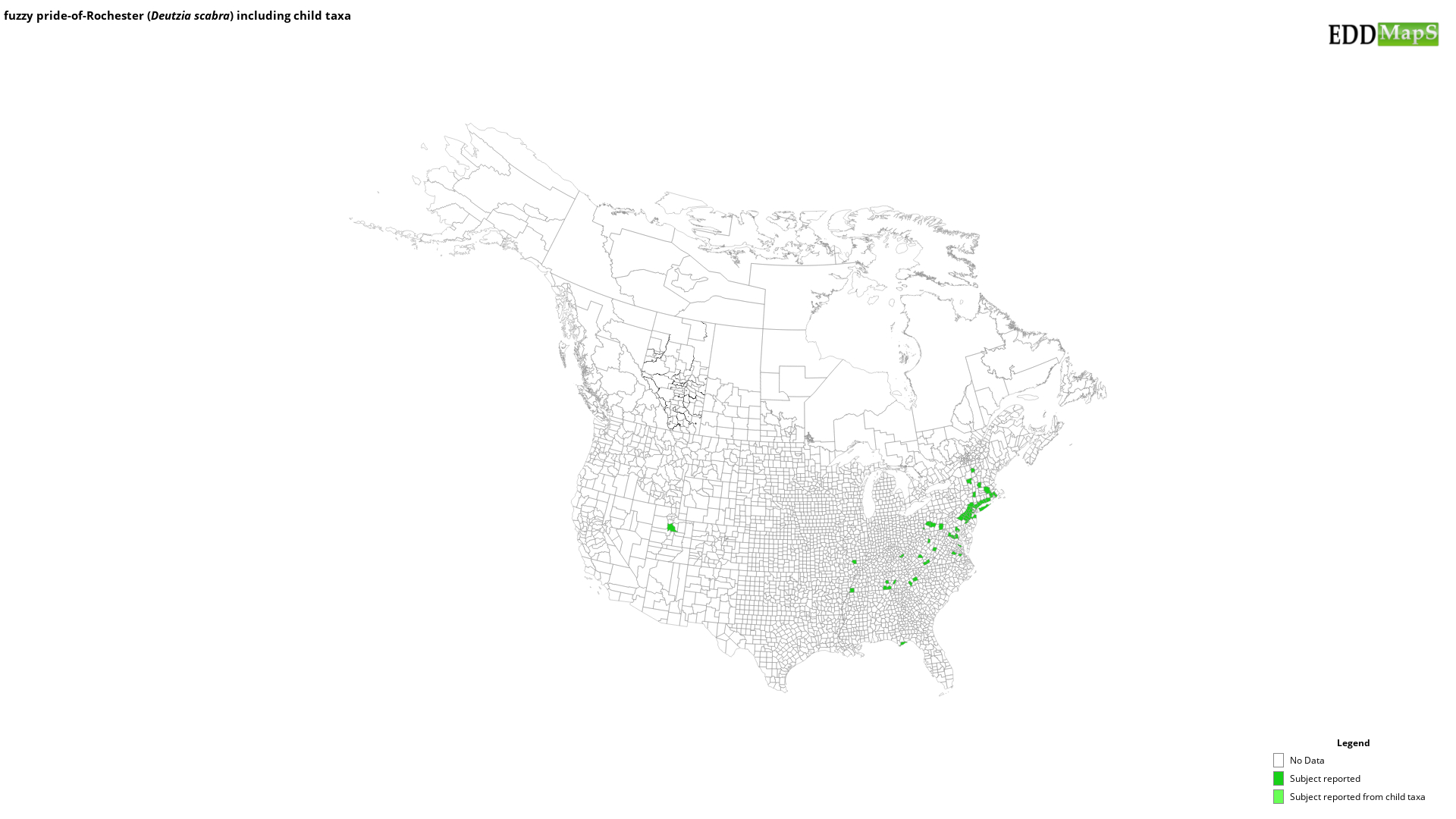fuzzy pride-of-Rochester
(Deutzia scabra)
This species is Introduced in the United States
Origin
Native to Japan.
Appearance
Deutzia scabra is an upright, deciduous shrub with arching branches that form a rounded crown. It grows from 6-10′ (1.8-3 m) tall and from 4-8′ (1.2-2.4 m) wide. The orange-brown bark on the trunk and larger branches will peel and hang down. It is native to Japan.
Foliage
The opposite oval to oblong leaves are dark green with toothed margins. The leaf is hairy and rough to the touch on both top and bottom surfaces.
Flowers
The small star-shaped white flowers may have a pink or purple tinge. They are fragrant with a honey-like scent. This shrub blooms in late spring.
Fruit
Fruits are small, brown, rounded, and cup-like.
Ecological Threat
D. scabra grows best in full sun and can tolerate a wide range of soil types as long as the soil is well-drained. It can also tolerate a fairly wide range of climatic conditions and has some drought tolerance.
Citations
Rawlins, K.A., R.L. Winston, C.T. Bargeron, D.J. Moorhead, and R. Carroll. 2018. New Invaders of the Northeast and Northcentral United States. USDA Forest Service, Forest Health Assessment and Applied Sciences Team, Morgantown, West Virginia. FHTET-2017-04. Retrieved from https://bugwoodcloud.org/resource/pdf/FHTET-2017-04_New%20Invaders_NE.pdf
Native to Japan.
Appearance
Deutzia scabra is an upright, deciduous shrub with arching branches that form a rounded crown. It grows from 6-10′ (1.8-3 m) tall and from 4-8′ (1.2-2.4 m) wide. The orange-brown bark on the trunk and larger branches will peel and hang down. It is native to Japan.
Foliage
The opposite oval to oblong leaves are dark green with toothed margins. The leaf is hairy and rough to the touch on both top and bottom surfaces.
Flowers
The small star-shaped white flowers may have a pink or purple tinge. They are fragrant with a honey-like scent. This shrub blooms in late spring.
Fruit
Fruits are small, brown, rounded, and cup-like.
Ecological Threat
D. scabra grows best in full sun and can tolerate a wide range of soil types as long as the soil is well-drained. It can also tolerate a fairly wide range of climatic conditions and has some drought tolerance.
Citations
Rawlins, K.A., R.L. Winston, C.T. Bargeron, D.J. Moorhead, and R. Carroll. 2018. New Invaders of the Northeast and Northcentral United States. USDA Forest Service, Forest Health Assessment and Applied Sciences Team, Morgantown, West Virginia. FHTET-2017-04. Retrieved from https://bugwoodcloud.org/resource/pdf/FHTET-2017-04_New%20Invaders_NE.pdf
Selected Images
Maps
EDDMapS Distribution - This map is incomplete and is based only on current site and county level reports made by experts, herbaria, and literature. For more information, visit www.eddmaps.org
State Lists - This map identifies those states that have this species on their invasive species list or law.
Invasive Listing Sources
- Jil M. Swearingen, Survey of invasive plants occurring on National Park Service lands, 2000-2007
- Kentucky Exotic Pest Plant Council - Moderate Threat
- National Park Service, Mid-Atlantic Exotic Plant Management Team Invasive Plant List
- New Invaders of the Northeast and Northcentral
- New Jersey Invasive Species Strike Team 2017 Invasive Species List
- WeedUS - Database of Plants Invading Natural Areas in the United States
Taxonomic Rank
| Domain: Eukarya |
| Kingdom: Plantae |
| Phylum: Magnoliophyta |
| Class: Magnoliopsida |
| Superorder: Asteranae |
| Order: Cornales |
| Family: Hydrangeaceae |
| Genus: Deutzia |
| Deutzia scabra |
References
Common Name Reference: USDA, NRCS. 2010. The PLANTS Database. National Plant Data Center, Baton Rouge, LA, USA.
Scientific Name Reference: USDA, NRCS. 2010. The PLANTS Database. National Plant Data Center, Baton Rouge, LA, USA.


